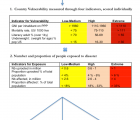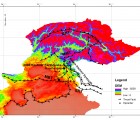Background: Preparedness for disasters and emergencies at individual, community and organizational levels could be more effective tools in mitigating (the growing incidence) of disaster risk and ameliorating their impacts. That is, to play more significant roles in disaster risk reduction (DRR). Preparedness efforts focus on changing human behaviors in ways that reduce people’s risk and increase their ability to cope with hazard consequences. While preparedness initiatives have used behavioral theories to facilitate DRR, many theories have been used and little is known about which behavioral theories are more commonly used, where they have been used, and why they have been preferred over alternative behavioral theories. Given that theories differ with respect to the variables used and the relationship between them, a systematic analysis is an essential first step to answering questions about the relative utility of theories and providing a more robust evidence base for preparedness components of DRR strategies. The goal of this systematic review was to search and summarize evidence by assessing the application of behavioral theories to disaster and emergency health preparedness across the world.
Methods: The protocol was prepared in which the study objectives, questions, inclusion and exclusion criteria, and sensitive search strategies were developed and pilot-tested at the beginning of the study. Using selected keywords, articles were searched mainly in PubMed, Scopus, Mosby’s Index (Nursing Index) and Safetylit databases. Articles were assessed based on their titles, abstracts, and their full texts. The data were extracted from selected articles and results were presented using qualitative and quantitative methods.
Results: In total, 2040 titles, 450 abstracts and 62 full texts of articles were assessed for eligibility criteria, whilst five articles were archived from other sources, and then finally, 33 articles were selected. The Health Belief Model (HBM), Extended Parallel Process Model (EPPM), Theory of Planned Behavior (TPB) and Social Cognitive Theories were most commonly applied to influenza (H1N1 and H5N1), floods, and earthquake hazards. Studies were predominantly conducted in USA (13 studies). In Asia, where the annual number of disasters and victims exceeds those in other continents, only three studies were identified. Overall, the main constructs of HBM (perceived susceptibility, severity, benefits, and barriers), EPPM (higher threat and higher efficacy), TPB (attitude and subjective norm), and the majority of the constructs utilized in Social Cognitive Theories were associated with preparedness for diverse hazards. However, while all the theories described above describe the relationships between constituent variables, with the exception of research on Social Cognitive Theories, few studies of other theories and models used path analysis to identify the interdependence relationships between the constructs described in the respective theories/models. Similarly, few identified how other mediating variables could influence disaster and emergency preparedness.
Conclusions: The existing evidence on the application of behavioral theories and models to disaster and emergency preparedness is chiefly from developed countries. This raises issues regarding their utility in countries, particularly in Asisa and the Middle East, where cultural characteristics are very different to those prevailing in the Western countries in which theories have been developed and tested. The theories and models discussed here have been applied predominantly to disease outbreaks and natural hazards, and information on their utility as guides to preparedness for man-made hazards is lacking. Hence, future studies related to behavioral theories and models addressing preparedness need to target developing countries where disaster risk and the consequent need for preparedness is high. A need for additional work on demonstrating the relationships of variables and constructs, including more clearly articulating roles for mediating effects was also identified in this analysis.




